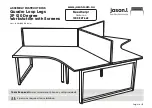
•
Avoid sharp or acute angles during implantation which could compromise the
patency of the catheter lumen (SL only).
•
Use suture wings to secure the catheter without compromising catheter patency.
•
Do not place sutures around catheter.
•
Do not use the device if there is any evidence of mechanical damage or leak-
ing. Damage to the catheter may lead to rupture, fragmentation and possible
embolism and surgical removal.
•
Accessories and components used in conjunction with this device should
incorporate Luer lock connections.
•
If signs of extravasation exist, discontinue injections. Begin appropriate med-
ical intervention immediately.
•
Infusion pressure greater than 25 psi (172 kPa) may damage blood vessels
and viscus and is not recommended. DO NOT USE A SYRINGE SMALLER
THAN 10 ml!
Possible Complications
The potential exists for serious complications including the following:
•
Air Embolism
•
Exit Site Infection
•
Phlebitis
•
Bleeding
•
Exit Site Necrosis
•
Spontaneous Catheter
•
Brachial Plexus Injury
•
Extravasation
Tip Malposition or Retraction
•
Cardiac Arrhythmia
•
Fibrin Sheath Formation
•
Thromboembolism
•
Cardiac Tamponade
•
Hematoma
•
Venous Thrombosis
•
Catheter Erosion
•
Intolerance Reaction to
•
Ventricular Thrombosis
Through the Skin
Implanted Device
•
Vessel Erosion
•
Catheter Embolism
•
Laceration of Vessels or
•
Risks Normally Associated
•
Catheter Occlusion
Viscus
with Local or General
•
Catheter-related Sepsis
•
Myocardial Erosion
Anesthesia, Surgery and
•
Endocarditis
•
Perforation of Vessels
Post Operative Recovery
or Viscus
III. After placement, observe the following precautions to avoid
device damage and/or patient injury:
• To reduce potential for blood backflow into the catheter tip, always remove
needles or needleless caps slowly while injecting the last 0.5 ml. of saline.
• For those unfamiliar with the procedure, published studies and a video are
available from
Bard Access Systems
depicting insertion and maintenance
techniques.
• For further information or questions, please call 800-443-3385 or
801-595-0700.
•
Follow Universal Precautions when inserting and maintaining the catheter.
•
Follow all contraindications, warnings, cautions, precautions and instructions
for all infusates as specified by its manufacturer.
•
Use aseptic techniques whenever the catheter lumen is opened or connected
to other devices. Chlorhexidine gluconate or povidone iodine are the suggest-
ed antiseptics to use. Acetone and tincture of iodine should not be used. 2%
Chlorhexidine/70% isopropyl alcohol swabsticks used for dressing changes
may be used.
•
The fluid level in the catheter will drop if the catheter connector is held above
the level of the patient’s heart and opened to air. To help prevent a drop in the
fluid level (and thus air entry) while changing injection caps, hold the connec-
tor below the level of the patient’s heart before removing the injection cap.
•
Examine the package carefully before opening to confirm its integrity and that
the expiration date has not passed. The device is supplied in a sterile pack-
age and is non-pyrogenic. Do not use if package is damaged, opened or the
expiration date has passed. Sterilized by ethylene oxide. Do not Resterilize.
•
Inspect kit for inclusion of all components.
•
Flush the catheter with sterile normal saline prior to use.
•
Avoid accidental device contact with sharp instruments and mechanical damage
to the catheter material. Use only smooth-edged atraumatic clamps or forceps.
•
Avoid perforating, tearing or fracturing the catheter when using a guidewire.
•
Do not use the catheter if there is any evidence of mechanical damage or
leaking.
II. To avert device damage and/or patient injury during placement.
I. Prior to beginning placement procedure, do the following:
4
5
Precautions
Precautions & Possible Complications



























